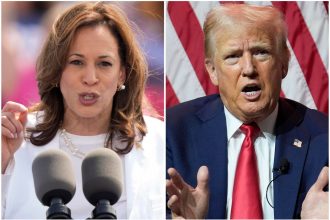A historic rematch between President Joe Biden and former President Donald Trump is heating up, and the road to the White House may come down to whose economic legacy succeeds at outshining the other.
The majority of Americans (89 percent) say the issue of handling the economy will be an important factor in determining their vote, with two-thirds (62 percent) calling it very important, according to Bankrate’s Biden and Americans’ Personal Finances Survey from November 2023. And for the first time since Grover Cleveland’s comeback attempt in 1892, voters have records of how the two leading candidates managed the world’s largest financial system.
To help Americans compare each president’s economic report card, Bankrate looked at data from Trump and Biden’s time in office on a sampling of economic measures, from hiring and unemployment, to stocks, growth, inflation and federal spending.
Both candidates’ resumes have economic feats worth bragging about, the analysis found. Biden is likely to tout that he presided over a historic job market, with half-century low unemployment and booming hiring. The economy under Trump, meanwhile, grew at nearly the same pace as it did under Biden when adjusting for inflation, even as the latter benefited from a massive post-pandemic boom.
But their records also have some red flags. Trump likely wants voters to blame Biden for the worst inflation crisis in 40 years, while Biden can point out that his predecessor added twice as much to the federal debt.
Whether Trump or Biden should take the blame or credit for the U.S. economy during their tenures in the White House, however, is an open question.
Presidents inherit much regarding the economy when they take office. In terms of the totality of their administrations, both Presidents Trump and Biden were largely able to preside over economies that enjoyed sustained growth and mostly low unemployment.
— Mark Hamrick, Bankrate Senior Economic Analyst
Key takeaways on Trump and Biden’s economic records
- Inflation: Prices have risen 19.3% since Biden took office, almost four times faster than the 5% increase three years and five months into Trump’s term.
- Hiring: Three years and five months into Biden’s term, the U.S. economy has created 15.6 million jobs. That compares with job losses totaling 12.6 million for Trump.
- National debt: Biden has so far added $4.3 trillion to the national debt, while Trump approved twice as much during his full term in office ($8.4 trillion).
- Growth: Since Biden took office, the U.S. economy has grown 8.4% when adjusted for inflation, versus a 6.5% growth rate for the same time period under Trump, though the economy was growing at a similar speed to Biden’s before the pandemic.
- Stocks: Overall, the S&P 500 stock index has risen 42.1% since Biden took office, compared with a 33.6% increase over the same time period for Trump, but stocks rose at a faster pace under the second and third year in Trump’s term than they did in Biden’s.
- Consumer sentiment: Confidence in the economy and Americans’ overall personal financial situations has been slumping under Biden, as inflation stays stubborn and consumers’ paychecks lose ground to price increases.
Prices have risen almost four times faster under Biden
Biden took office on the precipice of the worst inflation crisis in 40 years, an economic narrative likely to work against him considering that two-thirds of Americans (69 percent) say their cost of living has gotten worse since the November 2020 election, Bankrate polling from November found.
Since his inauguration in January 2021, prices have risen 19.3 percent, according to a Bankrate analysis of the latest available Bureau of Labor Statistics data. That’s nearly four times faster than inflation under the same period of time for Trump, with prices rising 5 percent between his inauguration in January 2017 and May 2020.
Much of the increase in prices stems from the coronavirus pandemic — including who was in the White House during the economy’s plunge (Trump) and red-hot bounce back (Biden). States enacted stay-at-home orders and shuttered nonessential businesses, sacrificing economic activity to curb the spread of the virus. As the gears of modern commerce came to a near standstill, the lack of demand ultimately ended up causing some deflation. Before the outbreak-induced recession occurred in February 2020, prices under Trump had risen 6.4 percent.
Later on, manufacturing shutdowns both within the U.S. and around the globe led to intense supply shortages. Illustrating that squeeze, prices for goods soared 13.6 percent in June 2022, contributing almost two-thirds (58 percent) to the annual 9.1 percent increase.
But post-pandemic inflation is also best described as a perfect storm. Both the Trump and Biden administrations approved some of the largest aid packages in history to help households weather the devastating recession, and researchers say those steps contributed to inflation, too.
Trump, for example, approved the $1.9 trillion Coronavirus Aid, Relief and Economic Security (CARES) Act, which sent households stimulus checks and scaled up jobless benefits for the unemployed. Once Biden took office, on the other hand, the chief executive ushered in the $2.1 trillion American Rescue Plan, sending a third stimulus check and expanding a tax credit for parents.
Research from the Federal Reserve Bank of San Francisco suggests that pandemic-era aid packages from both Biden and Trump may have added about 3 percentage points to inflation.
“In a world where finger-pointing has become a contact sport, the quick answer is that virtually every stakeholder in the economy is responsible, to some degree, for inflation,” Hamrick says. “But the biggest contributor to historically high inflation was supply chain disruptions at the beginning of the pandemic.”
Trump added twice as much to the federal debt as Biden
So far in Biden’s presidency, the chief executive has added $4.3 trillion to the national debt, with nearly half of that ($2.1 trillion) coming from pandemic-era relief programs, an analysis of federal spending from the bipartisan Committee for a Responsible Federal Budget shows.
Trump, on the other hand, approved twice as much during his full term in office: $8.4 trillion in federal spending, including $3.6 trillion of COVID relief, the analysis found.
Beyond pandemic-era relief, a major contributor to Trump’s federal spending was the Tax Cuts and Jobs Act (TCJA) of 2017, which added an estimated $1.9 trillion to the federal debt over a 10-year period.
Those findings exclude each president’s efforts to reduce the deficit. Biden’s actions are estimated to reduce $600 billion from the federal deficit over a 10-year period, while Trump’s efforts are earmarked at $443 billion.
Total debt held by the public now makes up over 122 percent of the U.S. economy’s total output, among the highest levels ever recorded, according to data from the St. Louis Fed. As interest costs soar, the trust funds of Medicare and Social Security barrel toward insolvency and tax cuts from Trump’s 2019 program approach their 2025 expiration date, the next president will likely have to toe a line between his party’s priorities and fiscal responsibility.
“Service of the ever-growing debt will conscribe greater and greater portions of government spending to the point where there simply are no dollars available for investment in infrastructure, technology and growth,” says Michael Farr, president and owner of D.C.-based investment firm Farr Miller and Washington. “The consensus plan seems to be to ignore the debt obesity, along with the diabetes and cardiac issues, until hospitalization of the economic patient is required. And even then — as long as an IV is available and vital signs are maintained — the issue will be ignored until the patient is in extremis.”
Biden oversaw a roaring post-pandemic job market
Since Biden’s inauguration in January 2021, the U.S. economy has created 15.6 million jobs. That compares with job losses totaling 12.6 million for Trump over the same time frame, thanks to the coronavirus pandemic-induced recession at the start of his fourth year in office.
Had the coronavirus pandemic not occurred, Trump was on pace to create 1.2 million positions by May 2020 — still well below job growth under Biden.
But that hiring was likely tied to the U.S. economy’s red-hot reopening. For the first year and a half of Biden’s term, for example, employers were simply adding back the positions that they cut during the pandemic.
Illustrating the historic rarity, payrolls have never expanded by 15.6 million positions in a 41-month period, employment records dating back to January 1939 from the Bureau of Labor Statistics show. The last time the financial system came close to creating that many positions was in January 1979, when employers created 11.6 million jobs since September 1975. The average pace of job creation over a period spanning three months and five years, meanwhile, is 4.8 million.
But excluding the pandemic-prone months (January 2021 through June 2022 for Biden and March 2020 through May 2020 for Trump), Biden’s average monthly pace of job growth was 269,000, compared with 180,000 for Trump.
Both are still historically strong. The average monthly pace of job growth since January 1990 is just 120,000.
The unemployment rate has fallen to even lower levels under Biden than it did for Trump
Unemployment has fallen 2.4 percentage points under Biden’s term so far, while rising 8.5 percentage points during the same period of Trump’s term (beginning at 4.7 percent and ending at 13.2 percent). Those gains, however, reflect the coronavirus pandemic.
Until the 2020 recession, Trump had presided over the longest expansion on record for the U.S. economy, watching unemployment steadily fall from 4.7 percent to a low of 3.5 percent during his term. Yet, by most measures, the job market during Biden’s stint in the White House has been even stronger, with joblessness falling to an even lower 3.4 percent in January 2023.
Excluding the massive surge in unemployment between March and May 2020, the unemployment rate under Biden has been lower than Trump’s for 18 of the 41 months of his term so far — largely thanks to the red-hot labor market of 2022 and early 2023. Even a gauge tracking the percentage of the workforce considered to be “underutilized” or “underemployed” held lower for Biden than it did for Trump.
One main contributing factor: Workers didn’t reenter the labor force immediately after the pandemic, leading to a mismatch between the supply of workers and the availability of open positions that would ultimately suppress the unemployment rate.
Yet, unemployment has been starting to edge higher under Biden, as the job market catches up to the highest interest rates from the Fed in over two decades. In the 32nd month of Biden’s term (October 2023), unemployment hit 3.8 percent, compared with a 3.6 percent rate at the same point in Trump’s presidential era.
Consumers have been less upbeat under Biden than they were for most of Trump’s presidency
Despite the booming job market under Biden, consumers have been less upbeat during Biden’s term – for all but one month, at least.
Confidence under Biden has averaged nearly 28 points lower than it was for Trump, while consumer confidence during Biden’s presidency hit a record low in June 2022, when inflation broke a new 40-year high.
| President | Peak | Trough | Average |
|---|---|---|---|
| Donald Trump | 101.4 | 71.8 | 96.5 |
| Joe Biden | 88.3 | 50 | 68.4 |
“Like real estate and politics, all personal finance is ultimately local,” Hamrick says. “Unemployment of a neighbor is not necessarily a shared experience. But surging inflation and elevated prices are very much universal, even though their impacts are not, varying based on financial resources and capability.”
Wages have grown faster under Biden but have lost more ground to inflation than under Trump
One reason why consumer confidence may be slumping: Americans’ wages haven’t been keeping up with inflation since Biden took office.
While wages and salaries for private-industry workers have grown faster under Biden (15 percent between the first quarter of 2021 and first quarter of 2024) than Trump (9.4 percent between the first quarter of 2017 and first quarter of 2020), they’ve lost greater ground when adjusted for price pressures.
Since Biden’s inauguration, prices on a quarterly basis have risen 17.9 percent — a near-3 percentage point gap. That compares with a 5.8 percent quarterly gain in prices under Trump, 3.6 percentage points lower than wage growth.
Excluding impacts from the pandemic, the economy has grown at about the same pace under both Biden and Trump
The U.S. economy grew at a faster pace at the start of Biden’s term, as the financial system recovered from the pandemic. On the flip side, the pandemic cratered activity under Trump.
But when comparing the pace of inflation-adjusted gross domestic product (GDP) growth for both presidents, the U.S. economy has performed similarly. Case in point: The economy’s “real” growth rate under Biden has come within two-tenths of a percentage point of Trump’s for five of his 13 quarters in office so far.
Trump’s strong inflation-adjusted growth rate could be because the chief executive spent two times as much as Biden on non-pandemic-related spending packages to juice up the economy. Trump’s TCJA, for example, led to a 4.5 percent annual growth rate in the fourth quarter of 2017, the largest pace of growth in over four years.
Overall, the U.S. economy has expanded 8.4 percent since Biden took office versus 6.5 percent for the same time period under Trump.
This key stock index under Biden is now trending higher than it was for Trump — after trailing the former president
The S&P 500 stock index has risen 42.1 percent since Biden took office, compared with a 33.6 percent increase over the same time period for Trump.
Like most other economic measures, however, that’s because the onset of the pandemic made financial markets jittery. Excluding the early days of the outbreak from the time frame, stocks under Trump rose at a faster pace than under Biden through the second and third year of his term.
Only recently has the S&P 500 regained ground, topping multiple record highs in 2024. That’s likely because investors have been fearful that the Fed could take its massive rate hikes too far, causing a recession.
The president usually ends up getting the credit or blame for the stock market’s performance. That’s just where the buck stops. So many other factors are at play – namely, Congressional spending, the Federal Reserve’s actions and just the rhythm of business cycles – that to pin the success or failure of stocks on one person is shortsighted, though it makes for good mudslinging.
— James Royal, Ph.D., Principal Writer at Bankrate
Bottom line: The economy’s strength isn’t always because of the president
The economy matters a great deal to Americans’ personal finances, impacting their job prospects, investments and ability to save for emergencies. But from the coronavirus pandemic to the Fed’s rapid rate hikes, forces outside the president’s control can often make or break the U.S. economy’s chances of avoiding a recession or inflation.
Had policymakers not rushed to limit the blow of the pandemic-induced recession, then supply shocks, ultralow interest rates and massive fiscal stimulus likely wouldn’t have combined to create the worst inflation crisis in 40 years.
Meanwhile, Americans have the Fed to thank for a job market that’s lost some steam — the price U.S. central bankers see as worth paying to defeat inflation. Yet, consumers don’t always first think of the Fed. Call it ignorance or a misplaced scapegoat, just 27 percent of Americans who say their personal financial situations haven’t gotten better blame the Fed for their individual financial situation, Bankrate’s November election poll found. Nearly half (45 percent), however, are pointing fingers at Biden.
“Presidents can do little relative to other forces affecting the economy, such as problems in getting cars and other products to market or keeping gas prices low, but people see presidents as a target to blame,” says Meir Statman, professor of finance at the Leavey School of Business at Santa Clara University. “Better to be lucky than good.”
-
Bankrate analyzed data from the Bureau of Labor Statistics, Department of Commerce, University of Michigan, Treasury Department, Committee for a Responsible Federal Budget and the Standard & Poor 500 index to determine how inflation, job growth, unemployment, gross domestic product (GDP), consumer confidence, wage growth, stocks and federal debts have performed under President Joe Biden and former President Donald Trump. To find the most accurate, apples-to-apples comparison, Bankrate indexed data to the first month of each candidate’s presidency (January 2017 for Trump and January 2021 for Biden) to the comparative period from which data is available. For example, consumer sentiment has only been published through April 2024, meaning data for Trump was pulled up until the same month (April 2020). Data on wage growth came from the Bureau of Labor Statistics’ employment cost index (ECI) to adjust for the wage composition of employed workers, as lower-wage industries were disproportionately cut during the pandemic.
Read the full article here














